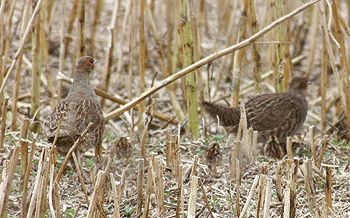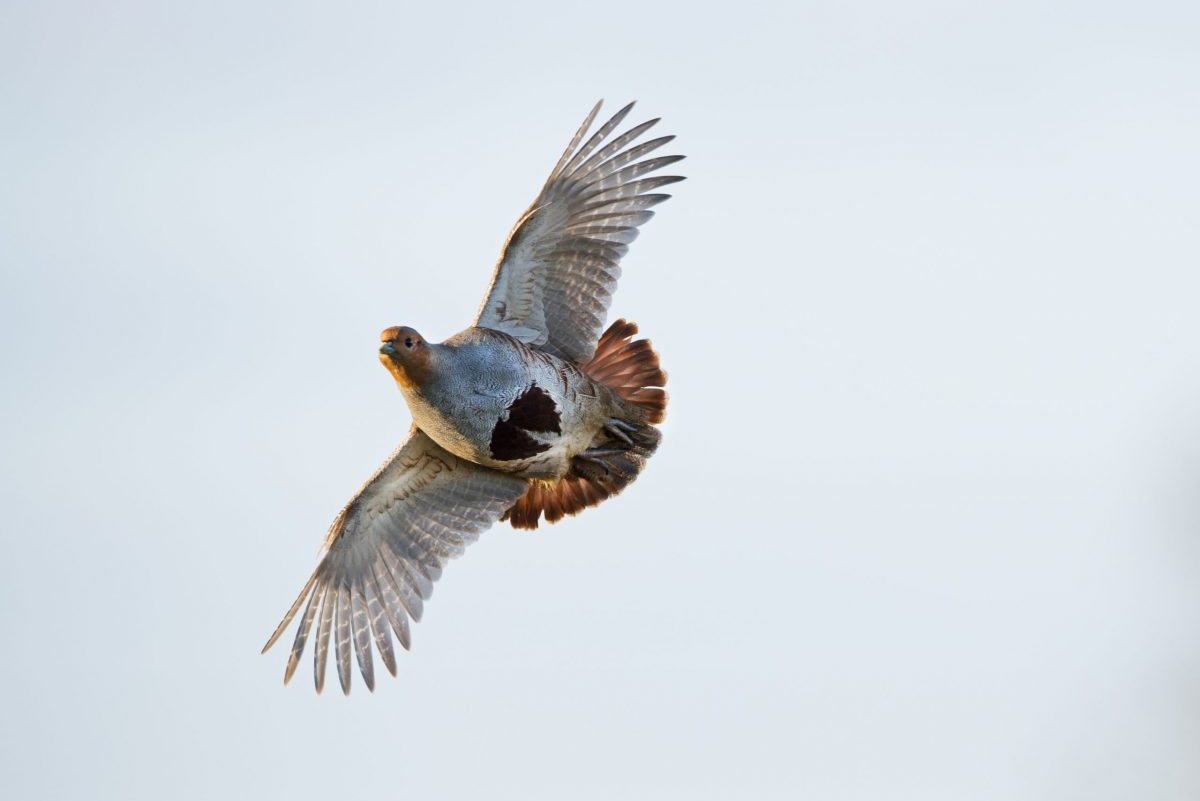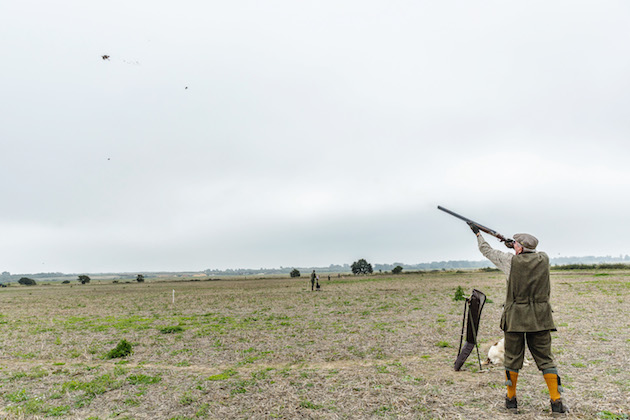How your shoot can help save the grey partridge
You don't have to be HM the Queen or the Duke of Norfolk to achieve a sustainable wild English partridge population on your shoot.

That was one of the central points I took away from the GWCT’s fascinating and practical course on reintroduction at Stoneleigh in Warwickshire last July.
Of course, there were plenty of other messages: it will be extremely challenging, it will cost money and you need to be committed for the long haul (10 years at least). But you don’t need to be a millionaire, you don’t need 10,000 acres, and you will succeed if you put the right pieces in place. Above all, we mustn’t give up on these remarkable birds and the ecosystems that sustain them.
There is a wealth of information packed into this inspiring one-day course, not least about the bird itself, which is extraordinary. The parents form a monogamous relationship, both raise the young and will fight to the death to defend them. A barren pair will foster orphaned chicks in the wild, as will a single cock bird, and the hens will lay and incubate the largest clutches of any wild bird, up to 25 eggs in total. With these strengths you would think the Englishman would be a great survivor but, sadly, it is increasingly vulnerable. UK numbers have declined by 86 per cent since the 1960s and promising recoveries were reversed last year because of the dreadful weather. Indeed, unless efforts to conserve it spread from the isolated success stories on a few great estates and the 1,000 farms already participating in the GWCT’s Partridge Count Scheme (the largest joined-up farm conservation project in Europe), the bird is at risk of coming off the quarry list and disappearing altogether.
It is vital that we work together to save the grey partridge, and the rewards will be great. In the medium term, for those involved, it promises to be a fascinating journey, which benefits a wide range of biodiversity. In the long term, it could add a new quarry to your shoot and potentially recoup some investment through let days, with wild greys commanding more money per bird than grouse.
The right food
The GWCT’s Roger Draycott began the one-day course by outlining what partridges need to survive in the wild. First is food. Partridge chicks primarily eat insects in their first two weeks, so unsprayed, insect-rich field margins are essential. Stewardship options such as conservation headlands and wild-flower mixes will attract the necessary sawfly larvae and other protein-packed invertebrates and provide the necessary cover to keep them out of sight from avian predators. Adult partridges used to depend on spilt grain left on over-winter stubble and less efficient drilling. Again, the loss of these can be mitigated through stewardship options such as birdseed mixes, hedgerow management and gamecrops, but hand feeding from autumn through to spring is vital and, thanks to the GWCT, there is now a grant that will help to pay for food to fill your hoppers, benefiting pheasants, partridges and a range of other farmland birds. However, there’s a risk of rats colonising the feeders, so supplementary feeding must be accompanied by rat control.
Having a variety of habitats is key. To nest, the birds look for hedgerows along strips of perennial tussocky grass, and they need late winter cover such as kale to protect them from predators. Finally, Roger explained that nowhere in Europe had partridge conservation been successful without predator control, so you will need a full-time keeper. If you have all these elements, the results can be dramatic. The GWCT project at Royston has shown convincingly that it is possible in five years to restore numbers from three to 17 pairs per 250 acres in a modern farming environment and successful grey partridge projects have 24 per cent more farmland birds and five times as many species.
Conditions and attitude
The GWCT’s senior grey partridge scientist, Dr Francis Buner, knows as much as there is to know about the difficult challenge of reintroduction. He began by telling us about a conference he’d been to in China, at which scientists were boasting about their multi-million-pound panda project. At the end, Buner asked them how the single animal they had released was faring and they had to admit sheepishly that it had been killed by a wild panda. There is no point in releasing partridges if the conditions are not suitable.
The right attitude also matters. In his view, those likely to be the most successful are people motivated by shooting and conservation, who are willing to work as a team with everyone from the scientific adviser to the crop sprayer. Another vital ingredient is the adaptive approach: you must be willing to adjust your management as time goes on. Importantly, you should consider releasing birds only if you have fewer than three pairs of wild greys per square kilometre, as this is already enough to build on. You will need a minimum of 4sq km or 1,000 acres to work with. However, you don’t need to have ownership over all of it – it could be a collaborative effort.
So where do you source your birds? Gamefarm-reared greys are worse than useless for reintroduction, Dr Buner says, as only about one in 1,000 released will survive to produce a successful brood. Wild birds are difficult to obtain from a sustainable population and you will get only one chance with them, so it is best to start with birds reared in conditions akin to the wild. On average, out of every 100 put down the previous autumn, 16 of these will survive till the following spring. It’s best to release family groups separately (about five groups of 15, each comprising a male, female and chicks) in the autumn or up to 20 pairs in the spring, making sure they are spread out but within hearing distance of each other. The reason for this is that partridges are less likely to disperse if other partridges are within hearing distance, especially single juvenile cock birds, which will wander up to 6km in search of a mate. Once the birds disperse, they are typically gone for ever.
You must place your release pens where they have all the ingredients for survival nearby, as walking to get food or shelter, or to find a nesting site, puts them at greater risk from predators. This will not only increase survival but also reduce dispersal. You should also colour-ring the released birds so that you can monitor their progress and distinguish them from wild birds. When the time comes to release the birds in the autumn, each family group must have its own pen and should be released up to a week after acclimatising.
Techniques
But where to source these magical reared birds with the necessary survival training? Former GWCT gamebird scientist Dr Dave Butler finished the talk by explaining that he has been developing techniques for rearing grey partridges specifically for reintroduction projects. Dave’s system is very extensive compared with a normal gamefarm. The cycle starts in January, when birds are allowed to pair up naturally before being moved to their own private 10ft x 10ft pen to nest. These pairs are then allowed to hatch and rear their own broods. Behaviour learnt from the parents at an early age is thought to be vital in preparing reintroduced birds for survival and reproduction in the wild.
Dave sees the future of the grey not just in the hands of wealthy landowners but also of smaller co-operative groups working together to bring this wonderful gamebird back, and he is happy to supply such projects. He also believes it is perfectly feasible to run a reared pheasant shoot alongside a grey partridge conservation project. He admits that the drier, more arable eastern parts of the country are more suitable, but he is convinced that people should give it a go even in non-traditional partridge areas where small wild populations once existed. If the shooting community were to succeed in its efforts to rescue the Englishman, it would go a long way to making the case for shooting as an essential element in the conservation of the UK’s biodiversity.








